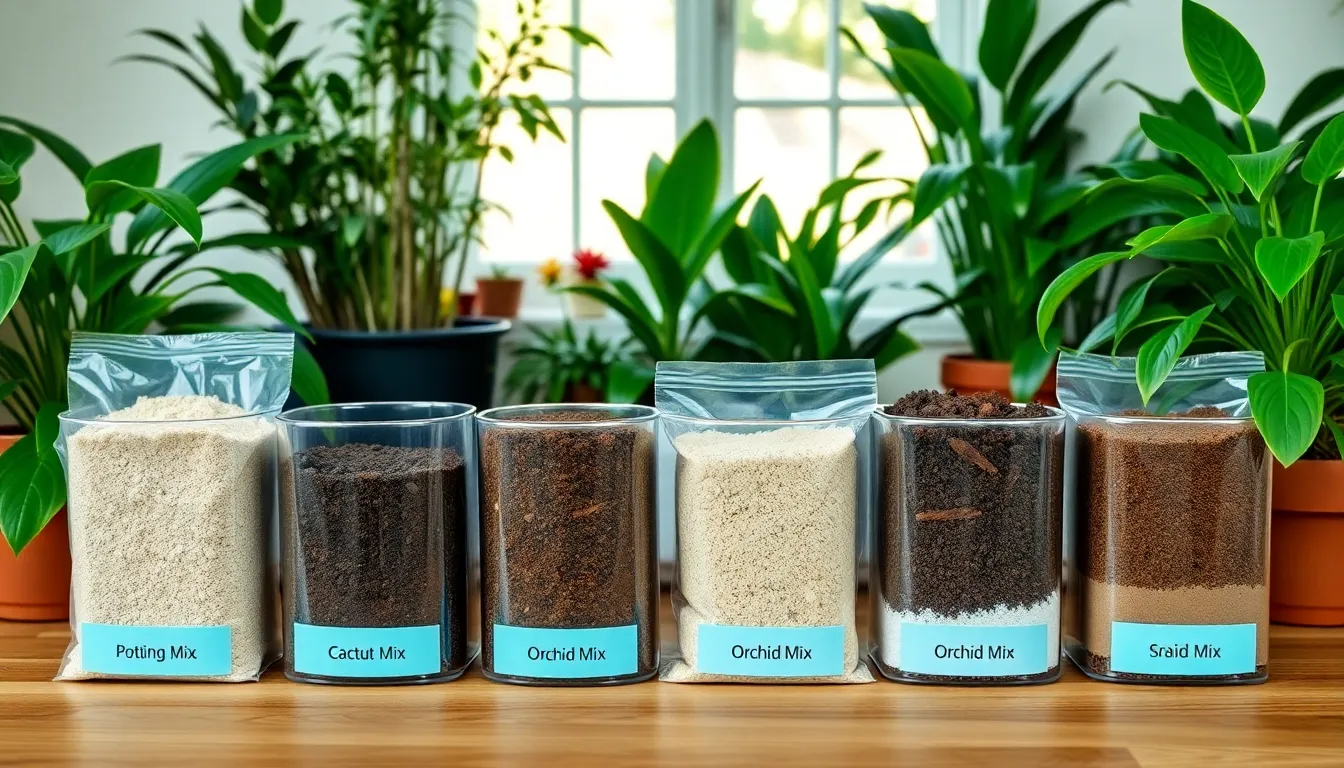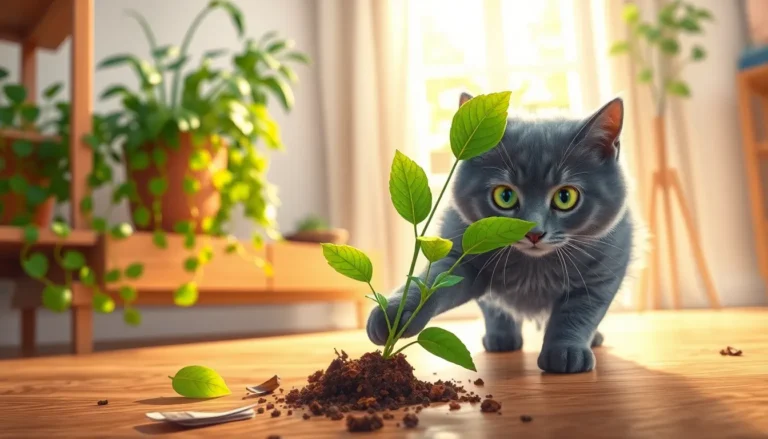Houseplants are like the friends who can’t stop growing on you—literally! But just like any good friendship, they need the right environment to thrive. Enter the world of potting soil, where the right mix can mean the difference between a flourishing green buddy and a sad, droopy leaf. Choosing the best soil for houseplants isn’t just a gardening chore; it’s a secret ingredient for success.
Best Soil for Houseplants
Choosing the right soil provides essential nutrients for houseplants. Proper soil supports healthy root development, enabling plants to access moisture and nutrients efficiently. Gardeners achieve optimal growth by ensuring that the soil composition matches the specific needs of each plant species.
Air circulation within the soil also plays a crucial role in plant vitality. It aids in root respiration and prevents issues such as root rot. Moreover, soil drainage impacts how well the plant retains water; too much can lead to suffocation, while too little can cause dehydration.
In addition, the pH level of soil affects nutrient availability. Most houseplants thrive in slightly acidic to neutral pH ranges between 6.0 and 7.0. Keeping the pH balanced ensures plants can effectively absorb essential trace elements.
Microbial activity in the soil contributes significantly to plant health. Beneficial bacteria and fungi break down organic matter, creating a rich environment for roots. This microbial community also enhances the soil’s ability to retain moisture.
Plant growth slows without an appropriate soil mix, which includes the right balance of organic matter and minerals. Standard potting mixes provide a good starting point, but specific requirements vary by plant type. Cacti thrive in fast-draining mixes, while ferns benefit from moisture-retaining soils.
Overall, selecting the appropriate soil ensures that houseplants receive a supportive environment, promoting robust growth and resilience against pests.
Types Of Soil For Houseplants

Selecting the right type of soil is essential for houseplants to thrive. Different plants benefit from specific soil compositions tailored to their unique needs.
Potting Mix
Potting mix serves as a versatile foundation for various houseplants. It typically combines peat moss, vermiculite, and perlite. This combination provides necessary drainage, aeration, and moisture retention. Organic matter in potting mix ensures that plants receive nutrients over time. Options exist for specific plant types, such as mixes with added fertilizers or moisture-retaining ingredients.
Cactus Mix
Cactus mix features a blend that supports succulents and cacti. This soil typically contains a higher proportion of sand or grit, enhancing drainage. Adequate drainage is crucial, as cacti are susceptible to root rot in overly moist environments. Many cactus mixes incorporate pumice or coarse perlite to ensure air circulation around the roots. Look for labeled products designed specifically for desert plants.
Orchid Mix
Orchid mix boasts larger particle sizes, allowing ample airflow to delicate roots. Common ingredients include bark, charcoal, and sphagnum moss. These materials create a porous medium that drains well while retaining some moisture. Orchids thrive in environments that mimic their natural habitats, often requiring customized blends. Choosing an appropriate orchid mix promotes healthy growth and stunning blooms.
Seed Starting Mix
Seed starting mix provides an ideal environment for germination. This blend tends to be finer, offering a light texture that helps seeds establish quickly. Components like vermiculite and peat moss help retain moisture without becoming waterlogged. Fertility isn’t as critical initially, as seeds rely on their stored nutrients. A specific seed starting mix enables successful early growth and robust seedlings.
Factors To Consider When Selecting Soil
Selecting the right soil involves multiple factors that significantly affect plant health. These aspects include drainage, nutrient content, and pH levels, each playing a vital role in supporting growth.
Drainage
Drainage ensures that excess water moves away from roots, preventing rot. Good soil promotes aeration, allowing roots to breathe and access necessary oxygen. Many potting mixes incorporate materials like perlite or coarse sand to enhance drainage. Cactus and succulent soils often feature higher sand concentrations for this reason. Roots thrive in well-draining environments, ultimately driving plant vitality.
Nutrient Content
Nutrient content is crucial for healthy plant development. Rich soils supply essential elements like nitrogen, phosphorus, and potassium, vital for growth and flowering. Organic matter, such as compost, boosts nutrient levels and microbial activity. A quality potting mix balances macronutrients and micronutrients to meet plant needs. Moreover, carefully selecting soil with the right nutrient profile directly influences overall plant health.
pH Levels
pH levels affect nutrient availability in the soil. Most houseplants prefer a pH range of 6.0 to 7.0, which allows optimal nutrient uptake. Soils too acidic or too alkaline inhibit growth and can lead to deficiencies. Testing soil pH can guide amendments to achieve desired levels. Adjusting pH, using lime to raise or sulfur to lower it, ensures a supportive growing environment for specific plant types.
Recommendations For Specific Houseplants
Selecting the right soil for specific houseplants enhances their growth and overall health. Different plant types thrive in various soil conditions.
Succulents
Succulents require well-draining soil that prevents water retention. A cactus mix works well due to its sandy composition, which allows excess moisture to escape. Most growers recommend combining potting soil with additional perlite or pumice for improved drainage. This mixture ensures roots stay aerated, reducing the risk of rot. Additionally, low nutrient levels suit succulent needs since they store nutrients in their leaves.
Ferns
Ferns flourish in soil that retains moisture but offers adequate drainage. A blend of potting soil with peat moss and perlite provides a light texture conducive to healthy fern growth. Organic matter is crucial for maintaining moisture levels without becoming waterlogged. Regularly monitoring humidity is also important, as ferns thrive in humid environments. Using a soil mix designed for ferns ensures optimal conditions for root development.
Flowering Plants
Flowering plants benefit from nutrient-rich soil that supports vibrant blooms. A potting mix containing organic fertilizers promotes growth through essential nutrients. Blending this mix with compost can improve soil structure, enhancing aeration and moisture retention. It’s beneficial to consider specific flowering plants when selecting soil, as some may prefer a slightly acidic mix. Regular fertilization during the growing season boosts flower production and overall plant health.
Conclusion
Choosing the right soil for houseplants is essential for their overall health and vitality. Each plant type has specific needs that can only be met with the appropriate soil composition. By understanding the unique requirements of succulents ferns and flowering plants gardeners can create an optimal environment for growth.
Investing time in selecting the right potting mix not only enhances nutrient availability but also improves drainage and aeration. This attention to detail results in robust plants that thrive and resist pests. Ultimately the right soil serves as the foundation for a flourishing indoor garden, ensuring that every plant reaches its full potential.




